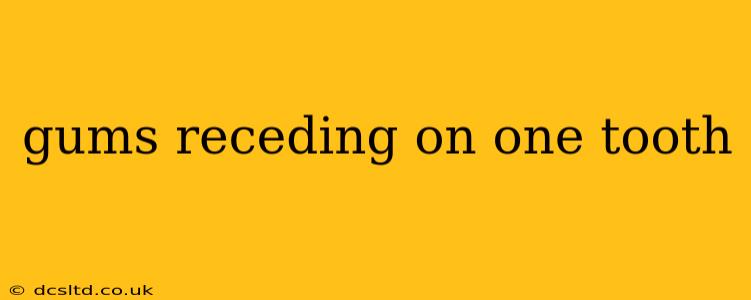Gum recession, where the gum tissue pulls back from the tooth, is a common dental problem. While it can affect multiple teeth, sometimes it only affects one. This can be alarming, but understanding the causes and treatment options can alleviate concerns and help prevent further recession. This article will explore the reasons behind gum recession on a single tooth, discuss available treatment methods, and offer valuable preventative strategies.
Why is My Gum Receding on Only One Tooth?
This is often the first question people ask when noticing gum recession on a single tooth. The answer isn't always straightforward, as several factors can contribute. Let's explore some of the key culprits:
-
Aggressive Brushing: Brushing too hard or using a hard-bristled toothbrush can wear away gum tissue over time. This effect is often localized, meaning it might impact one specific tooth more than others due to brushing habits.
-
Improper Flossing Technique: Incorrect flossing can also damage gums, particularly around one tooth if the technique consistently targets that area more aggressively.
-
Gum Disease (Periodontal Disease): This is a major contributor to gum recession. While it typically affects multiple teeth, the progression can sometimes be more pronounced on one particular tooth. Inflammation and infection break down the gum tissue and bone supporting the teeth.
-
Genetics: Some individuals are genetically predisposed to gum recession. This predisposition might manifest more significantly on one tooth due to anatomical variations in the gum line.
-
Misaligned Teeth or Bite: Teeth that are crooked or don't meet properly can put extra pressure on certain areas, leading to gum recession on the affected tooth.
-
Trauma: A physical injury to the mouth, such as a blow to the face, can cause localized gum recession.
-
Tooth Grinding (Bruxism): Grinding or clenching teeth can create excessive pressure on specific teeth, leading to gum recession in that area.
-
Certain Medications: Some medications can have gum recession as a side effect. It's essential to discuss any medications you are taking with your dentist or doctor.
What are the Treatments for Receding Gums on One Tooth?
Treatment options depend on the cause and severity of the recession. Your dentist will conduct a thorough examination to determine the best course of action. Common treatments include:
-
Scaling and Root Planing: This deep cleaning procedure removes plaque and tartar buildup from below the gum line, helping to reduce inflammation and improve gum health. This is often the first step in treating gum disease-related recession.
-
Gum Grafting: In more severe cases, gum grafting might be necessary. This surgical procedure involves taking gum tissue from another area of the mouth (often the palate) and attaching it to the area with receding gums to cover the exposed tooth root. Different types of gum grafts exist, and your dentist will recommend the most appropriate one based on your needs.
-
Connective Tissue Graft: This type of graft involves taking tissue from the palate, including connective tissue, to help build up the gum tissue around the receding tooth.
-
Free Gingival Graft: This utilizes tissue from the palate but doesn't include the underlying connective tissue.
-
Pedicle Graft: This involves using tissue adjacent to the affected area to cover the recession.
-
Pinhole Surgical Technique: This minimally invasive procedure uses specialized instruments to reposition the gum tissue without sutures, making it a less invasive option for some patients.
-
Addressing Underlying Issues: If misaligned teeth or bruxism are contributing factors, orthodontics (braces or aligners) or a mouthguard may be recommended.
How Can I Prevent Gums From Receding on One Tooth (or Any Tooth)?
Prevention is key to maintaining healthy gums. Here are some essential steps:
-
Gentle Brushing: Use a soft-bristled toothbrush and brush gently with short, back-and-forth strokes. Avoid scrubbing aggressively.
-
Proper Flossing Technique: Learn the correct flossing technique to avoid damaging your gums. Ask your dentist or hygienist to demonstrate proper technique if needed.
-
Regular Dental Checkups: Schedule regular checkups and cleanings (typically every six months) to detect and address gum problems early.
-
Maintain Good Oral Hygiene: This includes brushing twice a day, flossing daily, and using mouthwash as directed.
-
Quit Smoking: Smoking significantly increases the risk of gum disease and other oral health problems.
-
Manage Stress: Stress can negatively impact overall health, including oral health. Finding healthy ways to manage stress is important.
-
Maintain a Healthy Diet: A balanced diet rich in vitamins and minerals supports overall health, including gum health.
Remember, early detection and treatment are crucial for managing gum recession. If you notice your gums receding on one tooth or any other concerning changes in your oral health, schedule an appointment with your dentist immediately. They can accurately diagnose the cause and develop a personalized treatment plan to address your specific needs.
